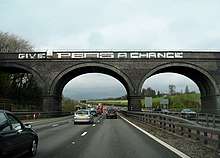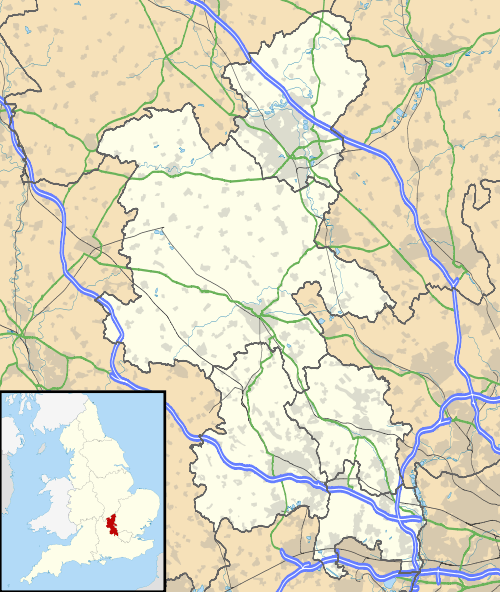Chalfont Viaduct
| Chalfont Viaduct | |
|---|---|
 Chalfont Viaduct seen from the M25 | |
| Coordinates | 51°34′56″N 0°32′05″W / 51.5822851°N 0.5346363°WCoordinates: 51°34′56″N 0°32′05″W / 51.5822851°N 0.5346363°W |
| OS grid reference | |
| Carries | Chiltern Main Line |
| Crosses | M25 Motorway |
| Locale | Gerrards Cross |
| Official name | Chalfont No. 1 Viaduct |
| Other name(s) | Misbourne Viaduct |
| Named for | The Chalfonts (Chalfont St Giles, Chalfont St Peter, Little Chalfont) |
| Owner | Network Rail |
| Characteristics | |
| Design | Arch |
| Material | Blue/black engineering brick |
| Total length | 104 metres (114 yd) |
| Height | 12.5 metres (41 ft) |
| No. of spans | 5, each 15.5 metres (51 ft) wide |
| Rail characteristics | |
| No. of tracks | 2 |
| Track gauge | 4 ft 8 1⁄2 in (1,435 mm) standard gauge |
| History | |
| Designer | James Charles Inglis, R.C. Sykes |
| Construction start | 1902 |
| Construction end | 1906 |
 Chalfont Viaduct Location of the Chalfont Viaduct in Buckinghamshire | |
The Chalfont Viaduct (also known as the Chalfonts Viaduct or the Misbourne Viaduct) is a five-arch brick railway viaduct on the Chiltern Main Line in south-east England. Located between Gerrards Cross and Denham Golf Club stations, it spans the M25 motorway between junctions 16 and 17. Technically, the bridge is Chalfont No. 1 Viaduct; the longer Chalfont No. 2 Viaduct is a short distance to the west.[1]
The bridge is noted as a local landmark because for more than 20 years it bore a graffiti slogan, "give peas a chance" painted in large white letters on the south-facing parapet.[2][3]
Construction

The Chalfont Viaduct is built of blue and black engineering brick with additional decorative brickwork. The bridge is approximately 12.5 metres (41 ft) high, although it varies in height due to changing ground level, and it has five semi-ellipical arches, each 15.5 metres (51 ft) wide. It was constructed between 1902 and 1906 by the Great Western Railway (GWR) to carry trains on the Great Western and Great Central Joint Railway between London and High Wycombe across the River Misbourne.[4][5] It was designed by James Charles Inglis, Chief Civil Engineer of the GWR, and Assistant Engineer Robert Cherry Sikes.[6]
In the mid-1980s the construction of the M25 motorway required the Misbourne to be diverted via underground concrete culverts. The route of the motorway was aligned to pass through the arches of the Chalfont Viaduct, leaving the viaduct largely unaltered apart from the raised ground level and the addition of concrete supports and crash barriers. The viaduct is the only brick-built bridge on this section of the M25.[5]
Graffiti
For many years the Chalfont Viaduct has borne a graffiti slogan, "give peas a chance" painted in large white letters on the south-facing parapet, visible to M25 drivers heading in a clockwise direction. The north side of the bridge bears the painted legend "peas06".[2]
Originally, the graffiti on the south parapet simply read "peas". It is thought that "Peas" was the tag of a London graffiti artist which can be seen on other locations. The words "give" and "a chance" were added later. The altered slogan may refer to the artist being repeatedly arrested, and it may also be a play on words in reference to John Lennon's popular 1969 song, "Give Peace a Chance".[7][4][8]
The graffiti has become a popular local landmark and is regarded affectionately by motorists as a reassuring location marker. When the graffiti was partially removed in 2018 it prompted media commentary.[9][10]
See also
References
Citations
- ↑ Maggs, Colin (2010). The Branch Lines of Buckinghamshire. Amberley Publishing Limited. p. 34. ISBN 9781445625584. Retrieved 20 September 2018.
- 1 2 Winterman, Tom de Castella and Denise (25 May 2011). "Campaigning by graffiti". BBC News. Archived from the original on 20 September 2018. Retrieved 20 September 2018.
- ↑ "Calls for M25 'give peas a chance' return". BBC News. 21 September 2018. Archived from the original on 21 September 2018. Retrieved 21 September 2018.
- 1 2 Hamilton, Ray (2015). M25: A Circular Tour of the London Orbital. Summersdale Publishers Limited. p. 59. ISBN 9781783726561. Retrieved 20 September 2018.
- 1 2 Kelly 2009, p. 1.
- ↑ Kelly 2009, pp. 2-3.
- ↑ Kelly 2009, p. 5.
- ↑ "The 'Give Peas a Chance' Bridge". Atlas Obscura. Archived from the original on 20 September 2018. Retrieved 20 September 2018.
- ↑ Clifton, Katy (20 September 2018). "Motorists devastated as iconic 'Give Peas a Chance' graffiti is erased". Evening Standard. Archived from the original on 20 September 2018. Retrieved 20 September 2018.
- ↑ "'Give peas a chance' M25 graffiti removed". BBC News. 18 September 2018. Archived from the original on 20 September 2018. Retrieved 20 September 2018.
Sources
- Kelly, Alison (2009). "Chalfont Viaduct Buckinghamshire - Historic Building Recording" (PDF). Oxford Archaeology. Archived (PDF) from the original on 20 September 2018. Retrieved 20 September 2018.
External links
| Wikimedia Commons has media related to Chalfont Viaduct. |